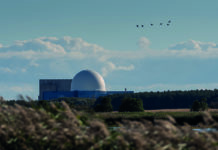Early June saw an important funding announcement for plans to establish one of the world’s first underground storage facilities for high-level nuclear waste, in Finland. Meanwhile, US plans to reclassify high-level waste in a safer category are proving contentious. Envirotec offers an update on nuclear waste storage

When it comes to appraising the amount of harm it presents, nuclear waste is classified as either high-, intermediate- or low-level. The most exacting in its requirements for handling and storage, high-level waste refers to material such as spent nuclear fuel, and waste materials derived from the reprocessing of this fuel. Although definitions appear to differ worldwide, what seems to distinguish this kind of waste is that it is highly radioactive and heat-generating. Intermediate-level waste, on the other hand, includes things like metal nuclear fuel cladding, sludges from the treatment of radioactive liquids, and graphite from reactor cores. Low-level waste contains relatively small amounts of mostly short-lived radioactivity, and comprises materials like rubble, soil and steel – it includes some materials produced by nuclear power generation, as well as materials from hospitals and industry.
Storing underground
The preferred destination for most waste is underground. As a rule, it seems, the longer-lived the waste, the deeper it has to go. So low-level waste is often buried in shallow landfill sites. Disposal approaches for intermediate-level waste, on the other hand, have included solidification in bitumen or concrete prior to burial. With high-level waste, the best available solution is Geological Disposal (GD), which means storing it in a specially engineered facility at considerable depth. In the UK this means 200m to 1000m below the surface (although 500m is seemingly more likely).
Despite a long-standing and seemingly unanimous consensus on GD as the best destination for this waste, attempts to locate and build a facility have faltered.
In the UK most high-level waste is stored above ground at the Sellafield site, in facilities and buildings whose provenance seems almost as old as the nuclear age itself, a situation that has been the focus of investigation by the BBC and others in recent years.
Geological disposal
With GD, the waste is packaged and stored in an underground facility specially engineered for this purpose. The properties of the surrounding rocks are germane to ensuring the materials’ safe and long-term consignment underground.
There are three different approaches to GD, defined by the type of rock in the surrounding environment: hard rock, salt rock, or clay.

There are 13 countries attempting to deploy GD at present. Preferred sites have already been identified in Sweden, Finland and France, while others – including Switzerland and Canada – appear to be getting closer to this point. Sweden seemingly suffered a postponement to its plans last year following an environmental court ruling that left questions around safety.
On 25 June the Finnish plans appeared to advance with the announcement by nuclear waste firm Posiva of a €500 million investment in an underground facility. This will house spent fuel materials and will be located next to the Olkiluoto nuclear power plant in Eurajoki, southwest Finland. Posiva is owned by the Finnish utilities TVO and Fortum, which plans to use the facility to store material from Olkiluoto and another nuclear plant, Loviisa. It will include a final disposal facility and an encapsulation plant.
A press release from Posiva hailed the move’s significance, which “means that safe final disposal will start first in the world in Olkiluoto,” according to Posiva president Janne Mokka, who has said it could be operational by the mid 2020s.
The storage cave will be located 400m deep, in a bedrock of granodiorite, a very fine form of granite, sections of which have already been carved out (see image, opposite). And these will later be subject to further engineering work to prepare the facility to house waste. The waste itself will be housed in a thick copper canister, which in turn will be surrounded by a casing of bentonite. This is a type of clay that expands when moist, allowing a very tight seal to be formed around the waste.
Previously attempts at GD have been predominantly in the salt-rock category of facility. For example, Germany’s Morsleben radioactive waste site, which seemingly stopped receiving waste in 1998 after it emerged that the surrounding rock structures had deteriorated. It is currently the focus of remediation efforts.
The US (New Mexico)-based Waste Isolation Pilot Plant (WIPP), began receiving waste in 1999. An accident at the WIPP in 2015 was seemingly caused by the accidental inclusion of cat litter within the waste form – the package used to house the material. This left organics sealed inside which produced gases, and seems to have been a problem to do with the operational management of the site – not keeping an eye on what was going into the waste packaging.
Safety case
Huge sums of money and a great deal of time, planning and engineering expertise is required to gain permission for a facility and then to build it. A prerequisite is the production of a “safety case”, which is a formal compilation of all the evidence and arguments that quantify and substantiate a repository’s claims to safety. In the UK it has to satisfy the EA of its safety over a period of 10k to a million years.
In the US, plans to secure long-term storage for dangerous waste have been stalled for decades. The 1982 Nuclear Waste Policy Act mandated the federal government to undertake the task of providing long-term storage, but the process reached stalemate in the late 1990s, and after two decades there is still no agreement on where to locate such facilities. Since then, spent fuel rods have been stored at nuclear power plants around the country, in either “fuel pools” (where they are left to cool for a few years) or in steel or concrete storage containers located above ground.
Yucca Mountain was picked by the US government in 1987 as a destination for waste, but this was later cancelled by Obama in 2009. Trump attempted to restart the licensing process in 2017, but Congress removed funds allowing him to do so from last year’s budget, according to Wired in a June article.
At present the main challenge is with “consent”, with state politicians having blocked attempts to locate a nuclear waste site in Nevada, Utah and Tennessee.
One novel circumvention of the problem might be in evidence with the US administration’s current plan – made public in June – to reclassify some of its current high-level waste, to lower its danger level and permit cheaper forms of disposal.
Nuclear waste in the US is stored at three principal locations: the Savannah River Plant in South Carolina, the Idaho National Laboratory and Hanford Nuclear Reservation in Washington state. About 60% of the most dangerous nuclear waste in the US is stored at Hanford, near Seattle, a site originally set up in the 1940s by the Manhattan Project, where there was a facility for enriching plutonium – a key ingredient of the atom bomb dropped on Nagasaki.
Environmentalists and local politicians fear it is a cost-cutting ploy and will lead to the shallow burial of dangerous forms of waste. Some of the contention around the issue centres on the definition of “high level”. Originally, this meant waste with provenance in military production. The US Department of Energy has recently argued that this is a “one size fits all” definition, and there should be more leeway, and discussion in this respect seem to have led to the current uncertainty.







